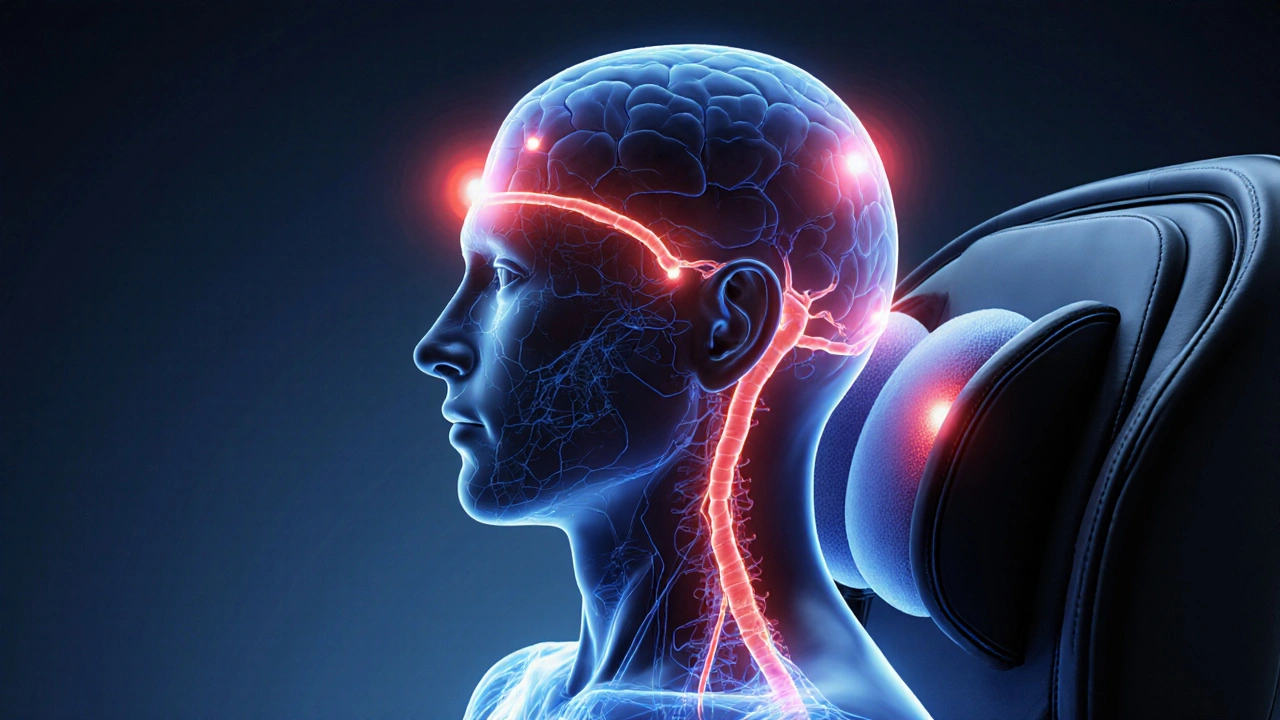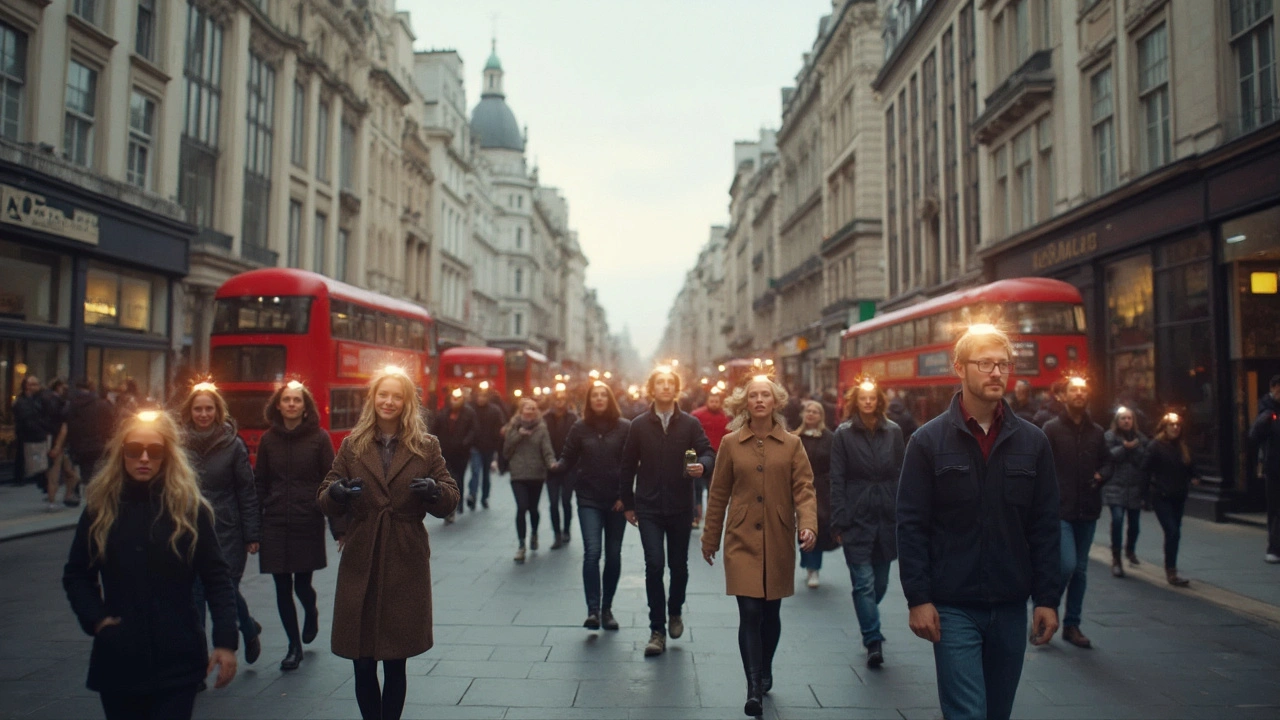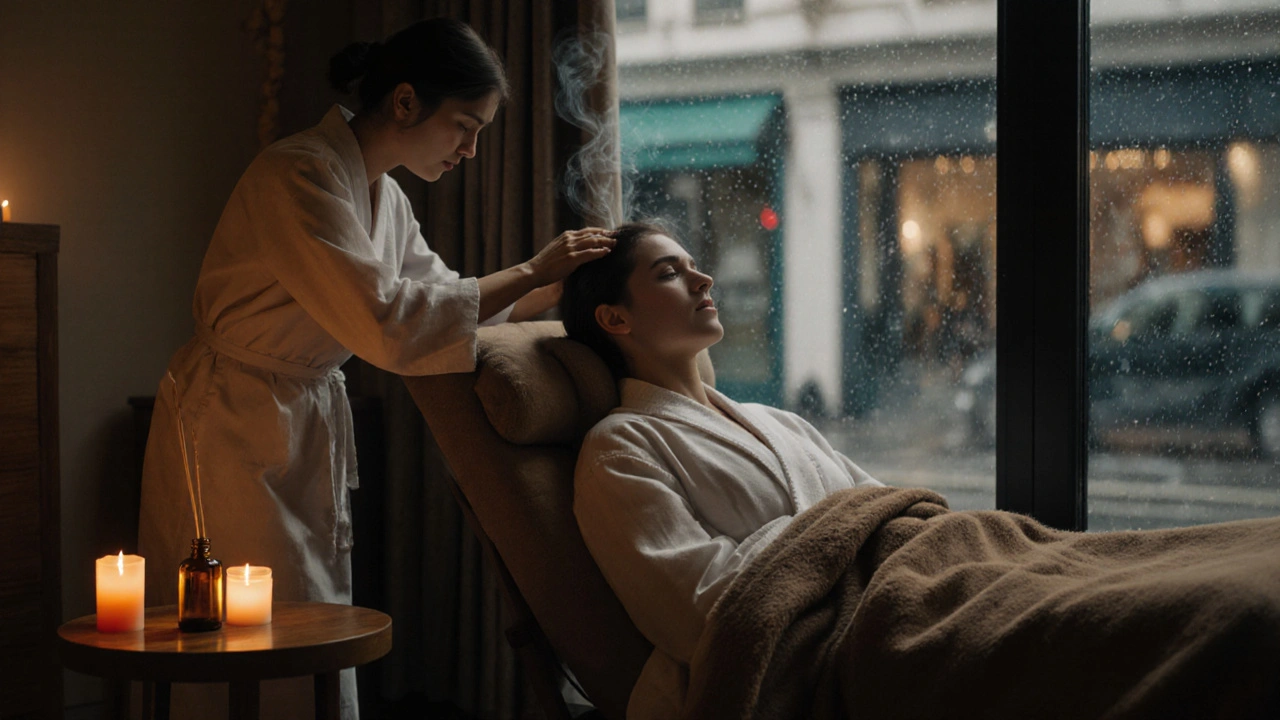Not sure what to wear for your Indian head massage in London? This guide covers exactly what clothes are best, how to prepare, and what to expect during your session. You’ll get practical tips so there are no surprises. Whether you’re a first-timer or a seasoned spa-goer, find out how to make your experience smooth and relaxing. Avoid rookie mistakes and walk in with confidence.

- Created by: Liam Redgate
- Completed on: 18 Nov 2025
- Categories: Head Massage
You sit there, eyes closed, hands gently working through your scalp, temples, neck-every muscle melting. Then, as soon as you sit up, the room spins. Your stomach drops. You feel like you’re going to pass out. Indian head massage is supposed to be relaxing, not terrifying. So why does this happen?
You’re not alone. Thousands of people in London, Manchester, and beyond report feeling lightheaded or dizzy after an Indian head massage. It’s not dangerous for most-but it’s confusing, and it shouldn’t be ignored.
What Exactly Is an Indian Head Massage?
Indian head massage, also known as Champissage, comes from ancient Ayurvedic traditions in India. It’s not just about rubbing your scalp. A typical session targets the head, face, neck, and shoulders using rhythmic kneading, circular motions, and gentle pulling. Practitioners use their thumbs, fingers, and palms to stimulate pressure points linked to energy flow-called marma points in Ayurveda.
Unlike Swedish or deep tissue massage, it doesn’t involve oil on the whole body. You stay fully clothed. The focus is on the upper body, especially areas where stress builds up: the forehead, behind the ears, the base of the skull, and the trapezius muscles. It’s designed to release tension, improve circulation, and calm the nervous system.
But here’s the thing: when you’re lying still for 20-30 minutes with your head lower than your heart-and then suddenly sit up-your body has to adjust fast. And sometimes, it doesn’t keep up.
Why Do You Feel Dizzy After an Indian Head Massage?
Dizziness after this massage isn’t random. It’s a physical reaction, and there are three main reasons why it happens.
1. Blood pressure drops too quickly
During the massage, your body relaxes deeply. Your heart rate slows. Blood vessels widen. Your blood pressure drops-this is normal. But when you sit or stand up too fast, gravity pulls blood downward. Your body doesn’t pump it back to your brain fast enough. That’s called orthostatic hypotension. It’s the same reason you feel faint after standing up too quickly from a chair.
2. Overstimulation of the vagus nerve
The vagus nerve runs from your brainstem down to your abdomen. It controls your heart rate, digestion, and how you respond to stress. Indian head massage applies pressure near the base of the skull and behind the ears-areas rich in vagus nerve endings. Too much stimulation can trigger a reflex that slows your heart and drops your blood pressure even more. This can cause lightheadedness, nausea, or even sweating.
3. Dehydration or low blood sugar
Most people don’t eat or drink much before a massage. If you’re already dehydrated or haven’t eaten in a few hours, your body is already running on low. The relaxation response from the massage makes it worse. Your brain needs glucose and fluid to stay alert. Without them, dizziness kicks in fast.
Who’s Most Likely to Feel Dizzy?
Not everyone gets dizzy. But some people are more prone to it:
- People with low blood pressure (even if they’ve never been diagnosed)
- Those who are pregnant
- Anyone with inner ear issues like vertigo or Meniere’s disease
- People who skip meals before the massage
- Those taking blood pressure or anxiety medications
- Individuals with a history of fainting or migraines
One client I spoke to in Camden, a 58-year-old teacher, said she’d feel dizzy after every session-until she started eating a banana and drinking water 30 minutes before. Problem solved.

How to Prevent Dizziness During and After
It’s not about avoiding Indian head massage-it’s about doing it smarter.
- Eat something light 30-60 minutes before. A banana, a handful of nuts, or yogurt gives your brain the fuel it needs.
- Drink water. Aim for at least one glass an hour before. Don’t chug right before-it’ll make you feel bloated.
- Ask your therapist to go slower. Tell them you’ve felt dizzy before. A good practitioner will adjust pressure and pace.
- Don’t jump up. When the massage ends, stay lying down for 1-2 minutes. Wiggle your fingers and toes. Then slowly roll to your side. Sit up slowly. Wait another 30 seconds before standing.
- Bring a snack. Keep a small bar or fruit in your bag. Eat it right after the session.
One London therapist I spoke to said she keeps dried apricots and bottled water in her studio for clients who feel faint. Simple, cheap, and effective.
When Should You Worry?
Most dizziness fades within a minute or two. But if you experience any of these, stop the massage and seek help:
- Blurry vision or double vision
- Severe headache or ringing in the ears
- Nausea that lasts more than 30 minutes
- Loss of balance or trouble walking
- Chest pain or irregular heartbeat
These could signal something more serious-like a neurological issue, inner ear disorder, or heart condition. Don’t brush it off. See your GP.

Indian Head Massage vs. Other Head Massages
Not all head massages are the same. Here’s how Indian head massage compares to others you might find in London:
| Feature | Indian Head Massage | Scalp Massage (Swedish Style) | Reflexology Head Treatment |
|---|---|---|---|
| Pressure Points | Yes-marma points along neck, scalp, face | Minimal-mostly gentle stroking | Yes-based on foot/hand reflex zones mapped to head |
| Duration | 20-45 minutes | 10-20 minutes | 15-30 minutes |
| Oil Used | Often herbal oils (like coconut or sesame) | Light oils or none | Usually none |
| Body Position | Lying down or seated | Usually seated | Seated |
| Dizziness Risk | Higher-due to pressure and full-body relaxation | Low | Low |
If you’ve had dizziness with Indian head massage but want the benefits, try a lighter scalp massage instead. It still reduces tension and improves circulation-but without the deep pressure that triggers vagus nerve responses.
Frequently Asked Questions
Is it normal to feel dizzy after an Indian head massage?
Yes, it’s relatively common, especially if you’re prone to low blood pressure, dehydrated, or stood up too quickly. Most cases are harmless and fade within minutes. But if it happens often or is severe, it’s worth checking with a doctor.
Can Indian head massage cause vertigo?
It can trigger vertigo if you already have an inner ear condition like BPPV (benign paroxysmal positional vertigo). The head movements and pressure changes can dislodge tiny crystals in your ear canal, causing spinning sensations. If you have vertigo, tell your therapist before the session-they can avoid certain movements.
Should I avoid Indian head massage if I have migraines?
Not necessarily. Many people with migraines find relief from gentle head massage. But avoid deep pressure on the temples or back of the neck during an active migraine. Wait until the pain eases. Some therapists specialize in migraine-friendly techniques.
Does drinking alcohol before a massage make dizziness worse?
Absolutely. Alcohol lowers blood pressure and dehydrates you. Add that to the relaxing effects of the massage, and you’re setting yourself up for a crash. Avoid alcohol for at least 6-8 hours before your session.
Can medication cause dizziness after a massage?
Yes. Blood pressure meds, antidepressants, diuretics, and even some anti-anxiety drugs can make you more sensitive to drops in blood pressure. If you’re on any medication, talk to your doctor before getting a massage. Your therapist should also know what you’re taking.
What to Do Next
Indian head massage is one of the most effective ways to relieve stress, improve sleep, and ease tension headaches. You don’t have to give it up because you felt dizzy once. Just adjust how you do it.
Next time, eat a snack. Drink water. Move slowly. Tell your therapist what happened. You’ll likely find that the dizziness disappears-and the benefits stay.
It’s not about avoiding the massage. It’s about respecting your body’s signals. Listen to them. Adapt. And keep relaxing.
Feeling like London is wearing you out? A head massage can be a total game-changer. This article digs into how head massage in London takes the edge off city stress, what different styles are out there, and where you can find top spots from Soho to Shoreditch. Flip through for clear tips, local insights, and trustworthy advice on prices, booking, and safety. Whether you’re new to massage or searching for your next go-to therapist, you’ll find lots to use here.
Discover how Indian head massage balances chakras, boosts prana, and deepens mindfulness. Learn types, prices, safety tips, and where to book in London.




Fred Lucas
November 19, 2025 AT 20:23It’s fascinating-though not surprising-that the vagus nerve is implicated here. One must, however, underscore that the Ayurvedic framework, while culturally rich, lacks empirical grounding in neurophysiology. The term ‘marma points’ is, frankly, a pre-scientific relic; modern neuroanatomy recognizes no such discrete energy nodes. The dizziness is entirely attributable to orthostatic hypotension and parasympathetic overstimulation-both well-documented in peer-reviewed literature. The fact that this is being framed as a mystical phenomenon rather than a biomechanical one is, regrettably, emblematic of the broader pseudoscientific drift in wellness culture.
Logan Gibson
November 21, 2025 AT 04:59Bro, you just said ‘marma points’ like it’s a real thing. Lol. It’s just pressure points with a Sanskrit accent. The real issue? People lie down like they’re in a spa version of a coffin, then pop up like they’re in a WWE match. I’ve had head massages in Delhi, Mumbai, and even a sketchy one in Vegas-dizziness only happened when the guy smacked my neck like he was trying to crack a walnut. Slow down. Eat something. Don’t be a zombie.
Manoj Kumar
November 22, 2025 AT 10:54Actually, the term is ‘marma sthāna’-not ‘marma points.’ The classical texts, such as the Sushruta Samhita, describe 107 such sites, not the watered-down, spa-adapted version you’re referencing. Furthermore, the assumption that Ayurveda is ‘pre-scientific’ is a colonial misinterpretation; it was a systematic, observational medicine long before Western physiology formalized concepts like autonomic regulation. Your reduction of this to ‘orthostatic hypotension’ ignores centuries of clinical observation. And yes, the dizziness is real-but it’s not just about standing up too fast. It’s about energy flow disruption. You wouldn’t understand.
ervin andriana taufik
November 22, 2025 AT 12:34so like… u just sit there n then boom-brain goes ‘wtf’? 😵💫 i got dizzy after a 5-min scalp rub at a gas station salon. i think it’s the combo of: 1) no food, 2) too much pressure on the neck, 3) my brain’s like ‘we didn’t sign up for this’ 😅. next time im eating a protein bar n sipping water like its my job. also-alcohol? nope. not even a sip. 🚫🍷
Matt Basler
November 22, 2025 AT 18:35You guys are overthinking this. Seriously. It’s not magic, it’s not conspiracy-it’s just your body saying ‘hey, slow down!’ 😊 The fix is stupid simple: eat a banana, drink water, and don’t rocket up from the table. I used to get dizzy too-then I started doing exactly what the post said. Now I get the chill vibes without the nausea. Trust me, your brain just needs a heads-up (pun intended). You got this. 💪